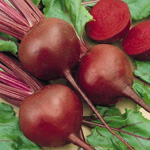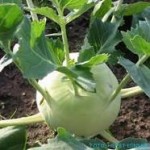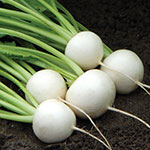Hello gardeners! We hope your winter planning season went well. (you have been planning your spring garden, haven’t you?) More now than ever, it is important for you to be food independent, and as a result we’ll have a bumper supply of seedlings available. Please call for availability though as weather during the next few weeks may affect the supply. IMPORTANT NOTICE! Every Saturday, starting April 31, 10am-2pm, I will be set up at Roscoes, 94 Green River Rd, Zirconia. Click HERE for a map.
All seedlings below will be available for $2.00/4-pack. 12 4-packs per flat (48 plants): $20.00
Beets 
The beet (Beta vulgaris) is a plant in the Chenopodiaceae family which is now included in Amaranthaceae family. It is best known in its numerous cultivated varieties, the most well known of which is the purple root vegetable known as the beetroot or garden beet. However, other cultivated varieties include the leaf vegetables chard and spinach beet, as well as the root vegetables sugar beet, which is important in the production of table sugar, and mangelwurzel, which is a fodder crop.
The beet has a long history of cultivation stretching back to the second millennium BC. The plant was probably domesticated somewhere along the Mediterranean, whence it was later spread to Babylonia by the 8th century BC and as far east as China by 850 AD. Available evidence, such as that provided by Aristotle and Theophrastus, suggests the leafy varieties of the beet were grown primarily for most of its history, though these lost much of their popularity much later following the introduction of spinach. The beet became highly commercially important in 19th century Europe following the development of the sugar beet in Germany and the discovery that sucrose could be extracted from them, providing an alternative to tropical sugar cane. It remains a widely cultivated commercial crop for producing table sugar.
Red Ace
Rapid growth, sweet flavor, and tenderness are the characteristics of Red Ace. The round, smooth, deep red roots size early, with high uniformity. They maintain their sweet tenderness when larger and older. Medium tall, red-veined greens for bunching.
Days to maturity: 43
Bull’s Blood
Deep burgundy leaves for salad or micro greens. Heirloom variety produces beautiful, dark red leaves to jazz up your salad mix even under low-light conditions. The foliage color intensifies as the plant matures. Striking, both baby and full size. Roots show attractive candy-striped zoning when sliced. Days to maturity: 45
Kohlrabi
Grand Duke
Kohlrabi belongs to the cabbage family and got its name from a German word meaning “cabbage-turnip”. They were popular in Germany during the 16th century and only recently have they been appreciated elsewhere. Technically Kohlrabi is not a root vegetable as both the leaves and swollen above-ground stem are edible and the roots are not eaten. Its flavor is milder than a turnip’s. If young and tender they may be eaten raw, very thinly sliced. Diced or julienned kohlrabi is good in salads, stir-fries, coated in batter and deep fried or steamed, and accompanied with a cheese sauce. If sliced kohlrabi is blanched first it can be frozen for up to 12 months.
Days to maturity: 55
Turnips
Hakurei White
This white salad turnip sets the standard for flavor. The flat-round, smooth, white roots mature early, just after radishes, and are best harvested young, up to 2″ diameter. Eaten raw the flavor is sweet and fruity, and the texture is crisp and tender. The dark green hairless tops are useful raw or lightly cooked with the roots. Hakurei stays smooth as it sizes. Days to maturity: 30
